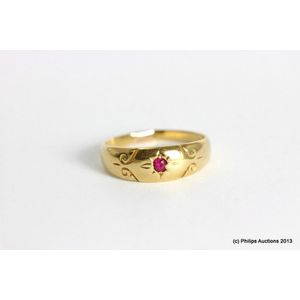Victorian Mahogany Wine Table with Glass Top
You must be a subscriber, and be logged in to view price and dealer details.
Subscribe Now to view actual auction price for this item
When you subscribe, you have the option of setting the currency in which to display prices to $Au, $US, $NZ or Stg.
- Provenance - A term used to describe the provable history of an antique or work of art, and thus an additional aid to verifying its authenticity. Provenance can have an inflating effect on the price of an item, particularly if the provenance relates to the early settlement of Australia, a famous person, or royalty. Less significant are previous sales of the item through an auction house or dealer.
- Victorian Period - The Victorian period of furniture and decorative arts design covers the reign of Queen Victoria from 1837 to 1901. There was not one dominant style of furniture in the Victorian period. Designers used and modified many historical styles such as Gothic, Tudor, Elizabethan, English Rococo, Neoclassical and others, although use of some styles, such as English Rococo and Gothic tended to dominate the furniture manufacture of the period.
The Victorian period was preceded by the Regency and William IV periods, and followed by the Edwardian period, named for Edward VII (1841 ? 1910) who was King of the United Kingdom and the British Dominions and Emperor of India for the brief period from 1901 until his death in 1910. - Mahogany - Mahogany is a dense, close grained red-coloured timber from the West Indies and Central America. It was first imported into Europe in the the early 18th century and its use continued through the 19th century. It was popular for furniture making because of its strength, the wide boards available, the distinctive grain on some boards, termed flame mahogany and the rich warm colour of the timber when it was polished.. The "flame" was produced where a limb grew out from the trunk of the tree, and this timber was usually sliced into veneers for feature panels on doors, backs and cornices.
Some terms used to describe mahogany relate to the country from which it originally came, such as "Cuban" mahogany, "Honduras" mahogany etc. However unless the wood has been tested the names assigned are more a selling feature, rather than a true indication of the timber's origin.
This item has been included into following indexes:
Visually similar items

A gentleman's white gold and steel America's Cup edition Seamaster Diver wristwatch, Omega, circa 2002. Automatic. 42 mm. Ref 2833.50.91. Serial number 60445352. Circular black dial with luminous markers and date aperture at 3 o'clock. White gold bezel. Ca

A Worcester Dr Wall blue and white sparrow beak cream jug, circa 1770. Of typical form, painted with flowers and butterfly, crescent mark, 10 cm high.

Colonial cedar brass bound blanket chest. Camphor wood lined, with original lock & key. Height 48, Wt.97 & Depth 46 cm

A stone set Gypsy ring, 18ct yellow gold, hallmarked Birmingham 1901, designed as a gypsy style band ring of graduating form, inset to centre with a hammer set red stone, flanked by engraved detail, tapering to reverse.
